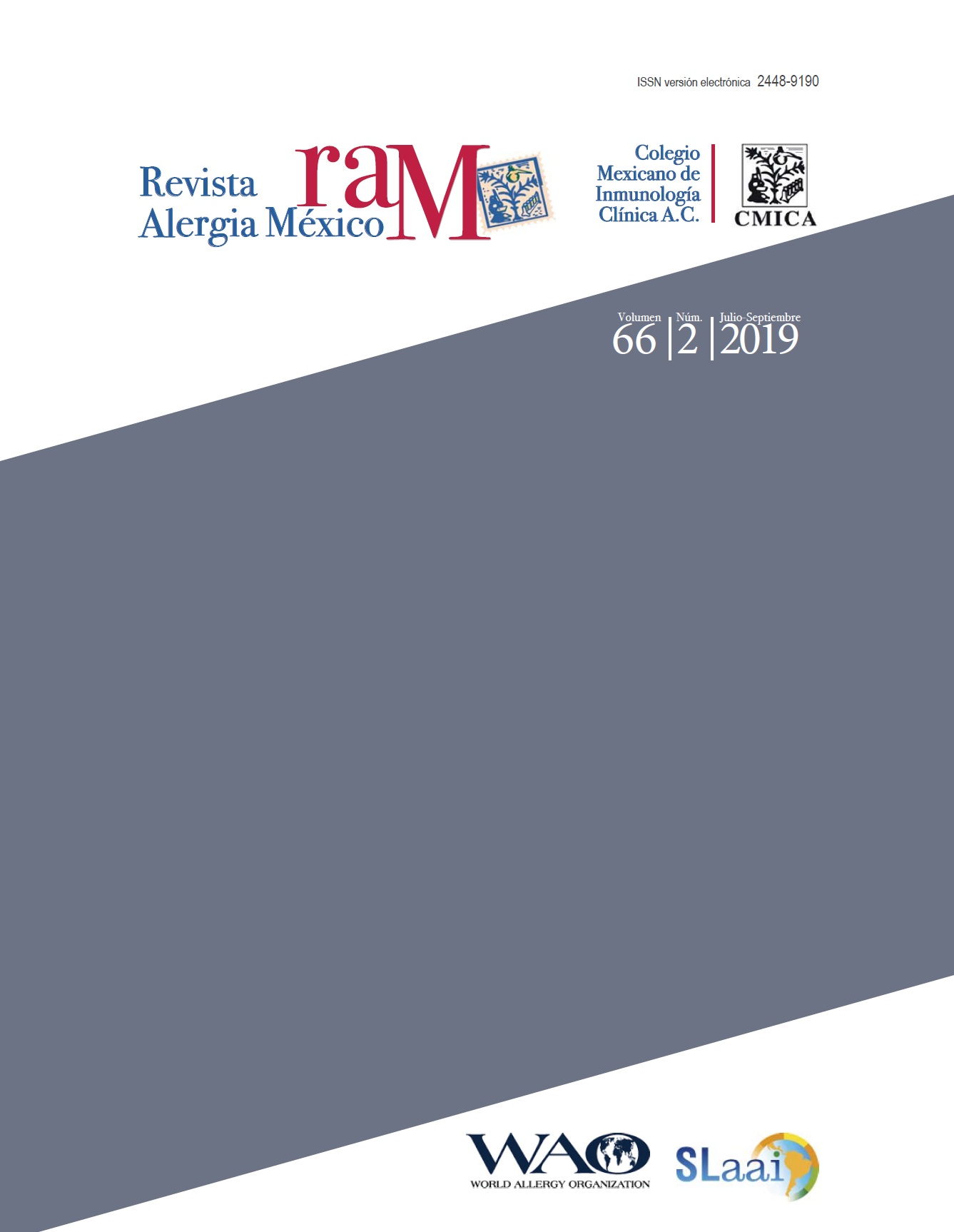Abstract
Background: There is limited epidemiological information on the treatment of atopic dermatitis (AD) from specialist physicians in Mexico.
Objective: To know the criteria that is used by specialists in Mexico to diagnose and treat AD.
Methods: An observational, descriptive and cross-sectional study, which was authorized by the ethics committee, was carried out through an electronic survey.
Results: 114 surveys were carried out; 56% of the participants were allergists, 38% were dermatologists and 5% were pediatricians. It was identified that 54% used clinical criteria for the diagnosis of AD and 42% used the criteria of Hanifin-Rajka as a diagnostic complement; 38% requested total and/or specific IgE, blood biometry and blood chemistry tests. They recount that 90% of patients under the age of 18 had mild AD, 8% had moderate AD and 2% had severe AD; and, in patients over the age of 18, 89% had mild AD, 6% had moderate AD and 5% had severe AD. The patients’ care was multidisciplinary, since 57% of the survey respondents requested assessments combined with ophthalmology, dermatology and allergology.
Conclusion: Knowledge of the disease will lead to a better control of the disease. The challenge is to have a patient registry, update treatment guidelines, consider comorbidities and have therapeutic options for its control.
References
Wollenberg A, Oranje A, Deleuran M, Simon D, Szalai Z, Kunz B, et al. ETFAD/EADV Eczema Task Force 2015 position paper on diagnosis and treatment of atopic dermatitis in adult and paediatric patients. J Eur Acad Dermatol Venereol. 2016;30(5):729-747. DOI: 10.1111/jdv.13599
Silvestre JF, Romero D, Encqabo B. Atopic dermatitis in adults: a diagnostic challenge. J Investig Allergol Clin Immunol. 2017;27(2):78-88. DOI: 10.18176/jiaci.0138
Sánchez J, Páez B, Macías A, Olmos C, De Falco A. Atopic dermatitis guideline. Position paper from the Latin America Society of Allergy, Asthma and Immunology. Rev Alerg Mex. 2014;61(3):178-211. Disponible en: https://nietoeditores.com.mx/nieto/Alergia/2014/jul-sep/pisition.paper_atopic.pdf
Weidinger S, Beck LA, Bieber T, Kabashima K, Irvine AD. Atopic dermatitis. Nat Rev Dis Primers. 2018;4(1):1. DOI: 10.1038/s41572-018-0001-z
Silverberg J. Public health burden and epidemiology of atopic dermatitis. Dermatol Clin. 2017;35(33):283-289. DOI: 10.1016/j.det.2017.02.002
Bannister MJ, Freeman S. Adult-onset atopic dermatitis. Australas J Dermatol. 2000;41(4):225-228. DOI: 10.1046/j.1440-0960.2000.00442.x
Boguniewicz M, Leung DY. Atopic dermatitis: a disease of altered skin barrier and immune dysregulation. Immunol Rev. 2011;242(1):233-246. DOI: 10.1111/j.1600-065X.2011.01027.x
Malik K, Heitmiller KD, Czarnowicki T. An update on the pathophysiology of atopic dermatitis. Dermatol Clin. 2017;35(3):317-326. DOI: 10.1016/j.det.2017.02.006
Werfel S, Allam JP, Biedermann T, et. al. Cellular and molecular immunologic mechanisms in patients with atopic dermatitis. J Allergy Clin Immunol. 2016;138(2):336-349. DOI: 10.1016/j.jaci.2016.06.010
Eyerich K, Eyerich S, Biedermann T. The multi-modal immune pathogenesis of atopic eczema. Trends Immunol. 2015;36(12):788-801. DOI: 10.1016/j.it.2015.10.006
Schmitt J, Langan S, Williams HC, European Dermato-Epidemiology Network. What are the best outcome measurements for atopic eczema? A systematic review. J Allergy Clin Immunol. 2007;120(6):1389-1398. DOI: 10.1016/j.jaci.2007.08.011
Chram ME, Spuls PI, Leeflang MM, Lindeboom R, Bos JD, Schmitt J. EASI, (objective) SCORAD and POEM for atopic eczema: responsiveness and minimal clinically important difference. Allergy. 2012;67(1):99-106. DOI: 10.1111/j.1398-9995.2011.02719.x
Eichenfield LF, Tom WL, Berger TG, Krol A, Paller AS, Schwarzenberger K, et al. Guidelines of care for the management of atopic dermatitis: section 2. Management and treatment of atopic dermatitis with topical therapies. J Am Acad Dermatol. 2014;71(1):116-132. DOI: 10.1016/j.jaad.2014.03.023
Hanifin JM, Reed ML, Eczema Prevalence and Impact Working Group. A population-based survey of eczema prevalence in the United States. Dermatitis. 2007;18(2):82-91. DOI: 10.2310/6620.2007.06034
Whiteley J, Emir B, Seitzman R, Makinson G. The burden of atopic dermatitis in US adults: results from the 2013 National Health and Wellness Survey. Curr Med Res Opin. 2016;32(10):1645-1651. DOI: 10.1080/03007995.2016.1195733
Chiesa-Fuxench ZC, Block J, Boguniewicz M, Boyle J, Fonacier L, Gelfand JM, et al. Atopic dermatitis in America study: a cross-sectional study examining the prevalence and disease burden of atopic dermatitis in the US adult population. J Invest Dermatol. 2019;139(3):583-590. DOI: 10.1016/j.jid.2018.08.028
Rincón-Pérez C, Larenas-Linnemann D, Figueroa-Morales MA, Luna-Pech J, García-Hidalgo L, Macías-Weinmann A, et al. Consenso mexicano para el diagnóstico y tratamiento de la dermatitis atópica en adolescentes y adultos. Rev Alerg Mex. 2018;65(Supl 2):s8-s88. Disponible en: http://revistaalergia.mx/ojs/index.php/ram/article/view/526/877
Secretaría de Salud. Guía de práctica clínica. Tratamiento de la dermatitis atópica. México: Secretaría de Salud; 2014.
Lee SC, Committee of Korean Atopic Dermatitis Association for REACH. Various diagnostic criteria for atopic dermatitis (AD): A proposal of Reliable Estimation of Atopic Dermatitis in Childhood (REACH) criteria, a novel questionnaire-based diagnostic tool for AD. J. Dermatol. 2016;43(4):376-384. DOI: 10.1111/1346-8138.13264

This work is licensed under a Creative Commons Attribution-NonCommercial 4.0 International License.
Copyright (c) 2019 Revista Alergia México

